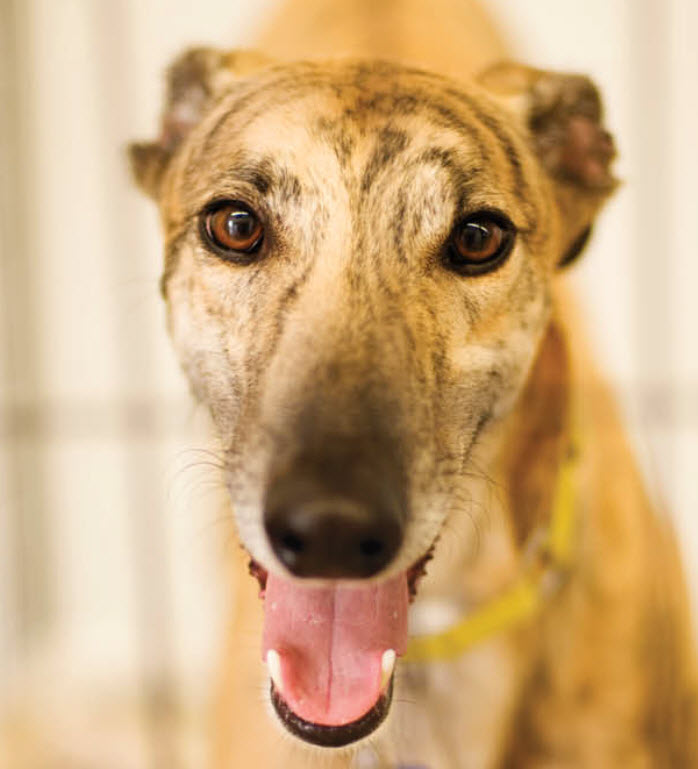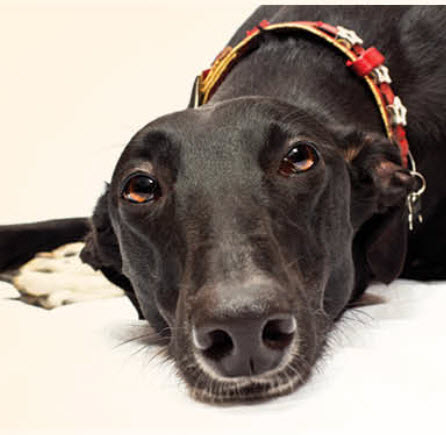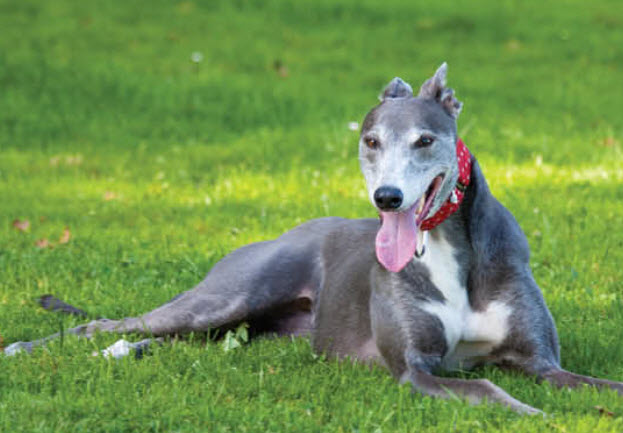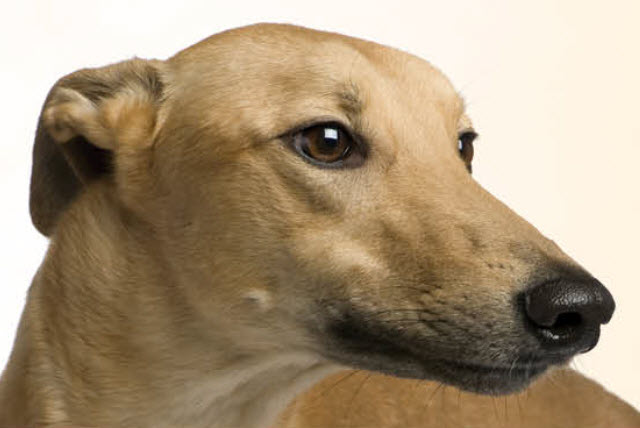
Greyhound
Greyhounds will Race into your Heart
Greyhounds are just great, for many reasons:
- Adaptable to a wide variety of living conditions
- Quiet—not much of a barker
- Needs minimal exercise
- Mild-mannered and easy to get along with
But put on the brakes, and think about these common traits:
- Exhibits signs of separation anxiety if left alone too much
- Sees cats and small animals as prey unless trained otherwise
- Can be difficult to housetrain
- Standoffish toward strangers

She is even-tempered, quiet, and has a low activity level indoors—an excellent housemate!
The Greyhound is an ancient breed thought to have originated in Egypt. Bred for speed, they were used for coursing game, including deer and hare. This sighthound is a popular racing dog bred for sprinting rather than endurance. The Greyhound is actually the fastest of all dogs, clocking in at speeds of up to 44 mph! They are also known as “40-mph couch potatoes” because while they are fast, they also enjoy resting at home. At home, the Greyhound is a gentle and laid-back dog that appreciates a comfortable place to sleep. Greyhounds are good with calm children and most family dogs.
Your Greyhound’s Health
We know that because you care so much about your dog, you want to take good care of her. That is why we have summarized the health concerns we will be discussing with you over the life of your Greyhound. By knowing about health concerns specific to Greyhounds, we can tailor a preventive health plan to watch for and hopefully prevent some predictable risks.
Many diseases and health conditions are genetic, meaning they are related to your pet’s breed. There is a general consensus among canine genetic researchers and veterinary practitioners that the conditions we’ve described herein have a significant rate of incidence and/or impact in this breed. That does not mean your dog will have these problems; it just means that she is more at risk than other dogs. We will describe the most common issues seen in Greyhounds to give you an idea of what may come up in her future. Of course, we can’t cover every possibility here, so always check with your Vida Veterinary Care medical team if you notice any unusual signs or symptoms.
This guide contains general health information important to all canines as well as the most important genetic predispositions for Greyhounds. This information helps you and us together plan for your pet’s unique medical needs. At the end of the article, we have also included a description of what you can do at home to keep your Needlenose looking and feeling her best. You will know what to watch for, and we will all feel better knowing that we’re taking the best possible care of your pal.
General Health Information for your Greyhound
Dental Disease
Dental disease is the most common chronic problem in pets, affecting 80% of all dogs by age two. Unfortunately, your Greyhound is more likely than other dogs to have problems with her teeth. Dental disease starts with tartar build-up on the teeth and progresses to infection of the gums and roots of the teeth. If we don’t prevent or treat dental disease, your buddy may lose her teeth and be in danger of damage to her kidneys, liver, heart, and joints. In fact, your Greyhound’s life span may even be cut short by one to three years! We’ll clean your dog’s teeth regularly and let you know what you can do at home to keep those pearly whites clean.
Infections
Greyhounds are susceptible to bacterial and viral infections—the same ones that all dogs can get—such as parvo, rabies, and distemper. Many of these infections are preventable through vaccination, which we will recommend based on her age, the diseases we see in our area, and other factors.
Obesity
Obesity can be a significant health problem in Greyhounds. It is a serious disease that may cause or worsen joint problems, metabolic and digestive disorders, back pain, and heart disease. Though it’s tempting to give your pal food when she looks at you with those soulful eyes, you can “love her to death” with leftover people food and doggie treats. Instead, give her a hug, brush her fur or teeth, play a game with her, or perhaps take her for a walk. She’ll feel better, and so will you!
Parasites
All kinds of worms and bugs can invade your Needlenose’s body, inside and out. Everything from fleas and ticks to ear mites can infest her skin and ears. Hookworms, roundworms, heartworms, and whipworms can get into her system in a number of ways: drinking unclean water, walking on contaminated soil, or being bitten by an infected mosquito. Some of these parasites can be transmitted to you or a family member and are a serious concern for everyone. For your canine friend, these parasites can cause pain, discomfort, and even death, so it’s important that we test for them on a regular basis. We’ll also recommend preventive medication as necessary to keep her healthy.
Spay or Neuter
One of the best things you can do for your Greyhound is to have her spayed (neutered for males). In females, this means we surgically remove the ovaries and usually the uterus, and in males, it means we surgically remove the testicles. Spaying or neutering decreases the likelihood of certain types of cancers and eliminates the possibility of your pet becoming pregnant or fathering unwanted puppies. Performing this surgery also gives us a chance, while your pet is under anesthesia, to identify and address some of the diseases your dog is likely to develop. For example, if your pet needs hip X-rays or a puppy tooth extracted, this would be a good time—it’s more convenient for you and easier on your friend too. Routine blood testing prior to surgery also helps us to identify and take precautions against common problems that increase anesthetic or surgical risk. Don’t worry; we’ll discuss the specific problems we will be looking for when the time arrives.
Genetic Predispositions for Greyhounds
Anesthesia
When it is time for a dental cleaning, surgery, or minor procedures such as suturing a wound, anesthesia is usually necessary. Greyhounds have a number of idiosyncrasies that can increase the risk of anesthesia. The good news is we have many years of experience with sighthounds and know to pay special attention to anesthetic problems such as:
- hyperthermia (body temperature dangerously high) in nervous dogs
- hypothermia (body temperature dangerously low) in dogs with a lean body conformation
- prolonged recovery from some intravenous anesthetics and increased risks of drug interactions
While we cannot eliminate these risks entirely, with attention, we are able to use anesthesia safely in these pets.
Bloat
Gastric dilatation volvulus, also known as GDV or bloat, usually occurs in dogs with deep, narrow chests. This means your Greyhound is more at risk than other breeds. When a dog bloats, the stomach twists on itself and fills with gas. The twisting cuts off the blood supply to the stomach and sometimes to the spleen. Left untreated, the disease is quickly fatal, sometimes in as little as half an hour. Your dog may retch or heave (but little or nothing comes up), act restless, have an enlarged abdomen, or lie in a prayer position (front feet down, rear end up). Preventive surgery in which the stomach is tacked down or sutured in place so that it is unlikely to twist is an option. If you see symptoms, take your pet to an emergency hospital immediately!
Cancer
Cancer is a leading cause of death among dogs in their golden years. Your Greyhound, however, is a bit more prone to certain kinds of cancer that can appear at a younger age. Many cancers are cured by surgical removal, and some types are treatable with chemotherapy, but for all types, early detection is critical! We’ll do periodic blood tests and look for lumps and bumps on your pet at each exam.
- Osteosarcoma is the most common bone tumor in dogs. It typically afflicts middle-aged large and giant breeds like your Greyhound. Early symptoms include lameness and leg pain. Early detection is critical! Call right away if you notice that your dog is limping. Osteosarcoma is a painful and aggressive tumor, and the sooner it is removed, the better his prognosis.
Bleeding Disorders
There are several types of inherited bleeding disorders that occur in dogs. They range in severity from very mild to very severe. Many times a pet seems normal until a serious injury occurs or surgery is performed, and then severe bleeding can result. Von Willebrand’s disease is a blood clotting disorder frequently found in Greyhounds. We’ll conduct diagnostic testing for blood clotting times or a specific DNA blood test for Von Willebrand’s disease and other similar disorders to check for this problem before we perform surgery.
Joint Disease
When Greyhound puppies are allowed to grow too quickly, the cartilage in their joints may not attach to the bones properly. This problem is known as osteochondritis dissecans, or OCD. If this occurs, surgery may be required to fix the problem. Our recommended growth rate for Greyhound puppies is no more than four pounds per week. To maintain this rate, don’t overfeed him and don’t supplement with additional calcium. Feed a large-breed puppy diet rather than an adult or regular puppy diet. And weigh your puppy every three to four weeks to make sure he’s on track.
Arthritis
Many older dogs have arthritis, and bigger dogs tend to have more pain and disability than smaller ones. Greyhounds are particularly prone to developing arthritis, but various treatments are available. The earlier we begin treatment, the better the results. Good nutrition and proper exercise are also very important to help reduce bone and joint problems as your pet gets older. Don’t let your pet become overweight, and save him a huge strain on his joints.
Back Problems
Intervertebral disc disease (IVDD) is a common condition in Greyhounds. The disease is caused when the jelly-like cushion between one or more vertebrae slips or ruptures, causing the disc to press on the spinal cord. If your dog is suddenly unable or unwilling to jump or go up stairs, is reluctant to move around, has a hunched back, cries out, or refuses to eat or go potty, he is likely in severe pain. He may even experience sudden paralysis—he may drag his back feet or be unable to get up or use his back legs. If you see these symptoms, don’t wait! Call us at (720) 738-6234 or call an emergency clinic immediately! In many cases involving paralysis, we’ll recommend surgical removal of the ruptured discs (within 24 hours of the onset of symptoms for the best results). For less severe cases, rest and medication may resolve the problem. And as with so many other diseases, weight control helps reduce the risk of IVDD. You should also provide ramps or steps for your pet from puppyhood on to prevent your dog from stressing his back by jumping on and off of the furniture.
High Blood Pressure
Greyhounds are more likely than other breeds to have high blood pressure, also called hypertension, which may occur independently or be caused by another disease. High blood pressure can cause blindness and strokes in dogs, just as it can in people. We’ll test his blood pressure on a regular basis and prescribe blood pressure medication if needed.
Eye Problems
Not many things have as dramatic an impact on your dog’s quality of life as the proper functioning of his eyes. Unfortunately, Greyhounds can inherit or develop a number of different eye conditions, some of which may cause blindness if not treated right away, and most of which can be extremely painful! We will evaluate his eyes at every examination to look for any signs for concern.
- Pannus is like a suntan on your dog’s eyeball. In affected breeds, inflammatory cells infiltrate the cornea (the clear part of the eye), which then darkens with exposure to ultraviolet light, and may lead to complete blindness. It’s considered to have a genetic component since the condition is predominant in certain breeds, like your Greyhound. We’ll watch his eyes closely for early signs and start preventive eye medications if needed. Doggie sunglasses are also an option to help reduce sun exposure.
- Progressive Retinal Atrophy (PRA) is an inherited disease in which the eyes are genetically programmed to go blind. Unfortunately, Grey Hounds are a bit more likely than other dogs to have this condition. PRA is not painful, but also not curable. In dogs with the bad gene, early symptoms such as night blindness or dilated pupils generally begin around three to five years of age. A genetic test is available for this condition.
Extra Teeth
Just as humans can have extra teeth, usually called wisdom teeth, some breeds of dog can have extra chompers as well. If these teeth erupt through the gums properly and are not too crowded, they are not harmful and may even be considered normal in some Greyhounds. Extra teeth that cause problems, however, should be removed during an anesthetic dental procedure to avoid the loss of more important teeth.
Inflammatory Bowel Disease
Inflammatory bowel disease, or IBD, is an immune system disorder common in Greyhounds in which the intestinal lining becomes overrun with immune system cells called lymphocytes and plasmacytes. The stomach and/or intestinal lining becomes thickened, affecting his ability to absorb nutrients properly. Chronic vomiting or diarrhea is common, or symptoms may flare up suddenly and then improve again for a time. Stress, diet change, or intestinal parasites can make IBD worse. If your friend has diarrhea or digestive upsets that are not explained by more common reasons, diagnostic tests, which may include intestinal biopsy, will be needed. Lifelong medications and special diets are usually required to keep IBD under control.
Epilepsy
There are three types of seizures in dogs: reactive, secondary, and primary. Reactive seizures are caused by the brain’s reaction to a metabolic problem like low blood sugar, organ failure, or a toxin. Secondary seizures are the result of a brain tumor, stroke, or trauma. If no other cause can be found, the disease is called primary or idiopathic epilepsy. This problem is often an inherited condition, and Greyhounds are commonly afflicted. If your friend is prone to seizures, episodes will usually begin between six months and three years of age. An initial diagnostic workup may help find the cause. Lifelong medication is usually necessary to help keep seizures under control with periodic blood testing required to monitor side effects and efficacy. If your dog has a seizure, carefully prevent him from injuring himself, but don’t try to control his mouth or tongue. It won’t help him, and he may bite you accidentally! Note the length of the seizure, and call us or an emergency hospital.
Megaesophagus
The esophagus carries food from the mouth to the stomach through downward contractions. If the esophagus isn’t contracting properly, food may remain in the esophagus, stretching it to “mega” size. If your Greyhound is affected, he may throw up tube-shaped portions of undigested food. Special feeding postures, dietary modifications, and medications may be needed to manage this problem. Unfortunately, dogs with megaesophagus commonly inhale bits of food while eating and can develop severe pneumonia. If you notice any unusual eating behaviors or vomiting after eating, be sure to let us know. A quick, painless x-ray can help us determine if your pet has this condition.
Allergies
In humans, allergies to pollen, mold, or dust make people sneeze. In dogs, rather than sneezing, allergies make their skin itchy. We call this skin allergy “atopy”, and Greyhounds often have it. The feet, belly, folds of the skin, and ears are most commonly affected. Symptoms typically start between the ages of one and three and can get worse every year. Licking the paws, rubbing the face, and frequent ear infections are the most common signs of allergies. The good news is that there are many treatment options available for these conditions.
Kidney Disease
Glomerulonephropathy is an inherited disease that slowly damages your Greyhound’s kidneys, causing them to fail, often at an early age. Because damaged kidneys leak protein, we may be able to diagnose this disease by annually testing your pet’s urine for excessive protein. Early detection leads to a happier pet and an easier, more affordable treatment plan. We may also recommend a special diet as part of his therapy.
Hair Loss
Both male and female Greyhounds are prone to genetically patterned baldness. As with balding men, the hair gradually falls out and does not grow back. This hair loss does not cause itchiness, though the skin can sometimes become dry. Affected areas usually include the throat, chest, belly, and the insides of the legs. We’ll conduct tests to rule out treatable problems that present hair loss as a symptom, such as hypothyroidism, but if it is true pattern baldness, supplements or hormones may help although there is no cure.
Taking Care of Your Greyhound at Home

Much of what you can do to keep your dog happy and healthy is common sense, just like it is for people. Watch her diet, make sure she gets plenty of exercise, regularly brush her teeth and coat, and call us or a pet emergency hospital when something seems unusual (see “What to Watch For” below). Be sure to adhere to the schedule of examinations and vaccinations that we recommend for her. This is when we’ll give her the necessary “check-ups” and test for diseases and conditions that are common in Greyhounds. Another very important step in caring for your pet is signing up for pet health insurance. There will certainly be medical tests and procedures she will need throughout her life and pet health insurance will help you cover those costs.
Routine Care, Diet, and Exercise
Build her routine care into your schedule to help your Needlenose live longer, stay healthier, and be happier during her lifetime. We cannot overemphasize the importance of a proper diet and exercise routine.
- Supervise your pet as you would a toddler. Keep doors closed, pick up after yourself, and block off rooms as necessary. This will keep her out of trouble and away from objects she shouldn’t put in her mouth.
- She has low grooming needs. Brush her coat as needed, at least weekly.
- Greyhounds often have serious problems with their teeth, so you’ll need to brush them at least three times a week!
- Clean her ears weekly, even as a puppy. Don’t worry—we’ll show you how!
- She is well suited to apartment life as long as she is given daily walks and short play sessions.
- She can have a high prey drive, so she needs to be leash walked and a sturdy fence is a must.
- She can be sensitive to cold, so a warm winter wardrobe is necessary.
- Keep your dog’s diet consistent and don’t give her people food.
- Feed a high-quality diet appropriate for her age.
- Exercise your dog regularly, but don’t overdo it at first.
What to Watch For
Any abnormal symptom could be a sign of serious disease or it could just be a minor or temporary problem. The important thing is to be able to tell when to seek veterinary help and how urgently. Many diseases cause dogs to have a characteristic combination of symptoms, which together can be a clear signal that your Greyhound needs help.
Office Calls
Give us a call for an appointment if you notice any of these types of signs:
- Change in appetite or water consumption
- Tartar build-up, bad breath, red gums, or broken teeth
- Itchy skin (scratching, chewing, or licking); hair loss
- Lethargy, mental dullness, or excessive sleeping
- Fearfulness, aggression, or other behavioral changes
Emergencies
Seek medical care immediately if you notice any of these types of signs:
- Scratching or shaking the head, tender ears, or ear discharge
- Inability or straining to urinate; discolored urine
- Cloudiness, redness, itching, or any other abnormality involving the eyes
- Dry heaving or a large, tight, painful abdomen
- Stiffness or reluctance to rise/sit/use stairs
- Any abnormal shaking, trembling, or excessive involuntary tremors
- Tubular vomit, undigested food



